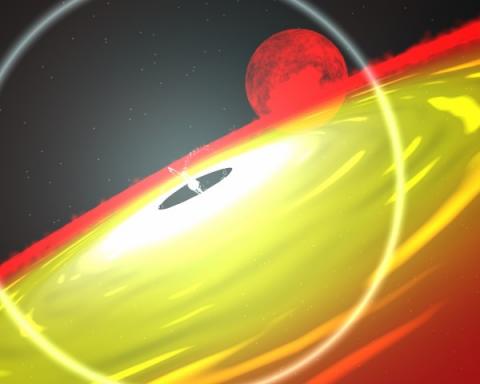Explanation: This dramatic artist's vision shows a city-sized neutron star centered in a disk of hot plasma drawn from its enfeebled red companion star. Ravenously accreting material from the disk, the neutron star spins faster and faster emitting powerful particle beams and pulses of X-rays as it rotates 400 times a second. Could such a bizarre and inhospitable star system really exist in our Universe? Based on data from the orbiting Rossi X-Ray Timing Explorer (RXTE) satellite, research teams have recently announced a discovery which fits this exotic scenario well - a "millisecond" X-ray pulsar. The newly detected celestial X-ray beacon has the unassuming catalog designation of SAX J1808.4-3658 and is located a comforting 12,000 light years away in the constellation Sagittarius. Its X-ray pulses offer evidence of rapid, accretion powered rotation and provide a much sought after connection between known types of radio and X-ray pulsars and the evolution and ultimate demise of binary star systems.
1999 2000 2001 2002 2003 2004 2005 2006 2007 2008 2009 2010 2011 2012 2013 2014 2015 2016 2017 2018 2019 2020 2021 2022 2023 2024 2025 |
Yanvar' Fevral' Mart Aprel' Mai Iyun' Iyul' Avgust Sentyabr' Oktyabr' Noyabr' Dekabr' |
NASA Web Site Statements, Warnings, and Disclaimers
NASA Official: Jay Norris. Specific rights apply.
A service of: LHEA at NASA / GSFC
& Michigan Tech. U.
|
Publikacii s klyuchevymi slovami:
pulsar - neutron star - neitronnye zvezdy - akkrecionnyi disk - Rentgenovskii pul'sar - dvoinye sistemy
Publikacii so slovami: pulsar - neutron star - neitronnye zvezdy - akkrecionnyi disk - Rentgenovskii pul'sar - dvoinye sistemy | |
Sm. takzhe:
Vse publikacii na tu zhe temu >> | |
